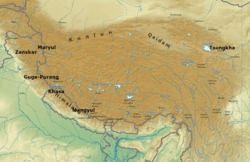Tsongkha
Tsongkha was a Tibetan theocracy that ruled northeastern Tibet from 997 to 1099.[1]
Tsongkha | |||||||||
|---|---|---|---|---|---|---|---|---|---|
| 997–1099 | |||||||||
 | |||||||||
| Capital | Tsongkha (modern Ping'an District) | ||||||||
| Common languages | Tibetan | ||||||||
| Religion | Buddhism | ||||||||
| Government | Theocracy | ||||||||
| History | |||||||||
• Established | 997 | ||||||||
• Disestablished | 1099 | ||||||||
| |||||||||
| Today part of | China | ||||||||
History
In 997 the elders of Amdo found a descendant of the Yarlung dynasty in Gaochang by the name of Qinanling Wenqianbu. They took him to Hezhou where they named him Gusiluo, otherwise known as Gyelsé, meaning "son of Buddha".[2]
In 1008 Gusiluo was enthroned at Kuozhou as Tsenpo.[2]
In 1017 Tsongkha was defeated by the Song dynasty commander Cao Wei.[3]
In 1025 Gusiluo relocated to Miaochuan.[3]
In 1032 Gusiluo relocated to Qingtang.[4] Around the same time his eldest son Xiazhan established himself in Hezhou and his second son Mozhanjiao in Tsongkha.[5]
In 1054 assisted the Song army in resolving a dispute among Tibetan tribes.[5]
In 1058 a Khitan princess married Gusiluo's son Dongzhan.[6] Dongzhan killed Xiazhan and Mozhanjiao.[5]
In 1065 Gusiluo died and was succeeded by his son Dongzhan. Mucheng, son of Xiazhan, declared independence in Hezhou.[7]
In 1070 the monks Jiewuchila and Kangzunxinluojie attempted to enthrone Mucheng's younger brother Donggu at Wushengjun but failed.[7]
In 1072 the Song dynasty regained control of Wushengjun.[8]
In 1074 Dongzhan and Mucheng submitted to Song governance.[8]
In 1099 Tsongkha was briefly occupied by the Song dynasty before regaining independence.[1]
From 1102 to 1104 Song armies occupied the region again and renamed Qingtang to Xining.[9]
By 1109 the Song dynasty had registered all the Tibetan towns of Kokonor under Chinese names.[9]
In 1136 the Jin dynasty (1115–1234) ceded the area to the Western Xia.[10]
References
- Tuttle 2013, p. xvii.
- Twitchett 1994, p. 173.
- Twitchett 1994, p. 175.
- Twitchett 1994, p. 176.
- Tuttle 2013, p. 152.
- Twitchett 1994, p. 192.
- Tuttle 2013, p. 153.
- Tuttle 2013, p. 154.
- Twitchett 1994, p. 196.
- Twitchett 1994, p. 180.
Bibliography
- Tuttle, Gray (2013), The Tibetan History Reader, Columbia University Press
- Twitchett, Denis (1994), The Cambridge History of China, Volume 6, Alien Regime and Border States, 907-1368, Cambridge: Cambridge University Press, ISBN 0521243319